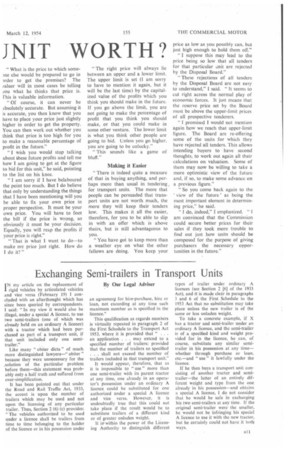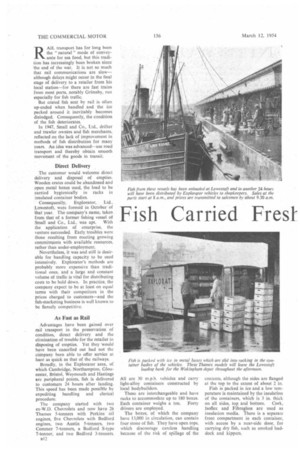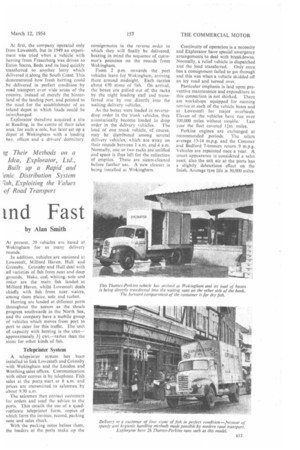Exchanging Semi-trailers in Transport Units
Page 45

Page 46

Page 47

If you've noticed an error in this article please click here to report it so we can fix it.
By Our Legal Adviser INmy article on the replacement of rigid vehicles by articulated vehicles and vice versa (February 19) I concluded with an afterthought which has since been queried by correspondents. I said: In my view it would also be illegal, under a special A licence, to use two semi-trailers (one of which was already held on an ordinary A licence) with a tractor which had been purchased as part of a transport unit, if that unit included only one semitrailer."
Like many " °biter dicta" of much more distinguished lawyers—" obiter " because they were unnecessary for the ,solution of the particular problem before them—this statement was probably only a half truth and suffered from over-simplification.
It has been pointed out that under the Road and Rail Traffic Act, 1933, the accent is upon the number of trailers which may be used and not upon the licensing of any particular trailer. Thus, Section 2 (6) (c) provides: "The vehicles authorized to be used under a licence shall be trailers from time to time belonging to the holder of the licence or in his possession under
an agreementj for hire-purchase, hire or loan, not exceeding at any time such maximum number as is specified in the licence."
This qualification as regards numbers is virtually repeated in paragraph 2 of the First Schedule to the Transport Act 1953, where it is provided that " . . an application . . may extend to a specified number of trailers: provided that the number of trailers so specified . . . shall not exceed the number of
• trailers included in that transport unit."
It would appear, therefore, that as it is impossible to " use " more than one semi-trailer with its parent tractor at any time, one already in an operator's possession under an ordinary A licence could be substituted for one authorized under a special A licence and vice versa. However, it is undoubtedly true that this could not take place if the result would be to substitute trailers of a different kind or of greater unladen weight.
It ig within the power of the Licensing Authority to distinguish different
types of trailer under ordinary A licences (sec Section 2 [6] of the 1933 Act), and it is made clear in paragraphs 3 and 6 of the First Schedule to the 1953 Act that no substitution may take place unless the new trailer is of the same or less unladen weight.
To take a concrete example, if X has a tractor and semi-trailer under an ordinary A licence, and the semi-trailer is of a specified kind and weight provided for in the licence, he .can, of course, substitute any similar semitrailer in his possession at any time— whether through purchase or loan. etc.—and " use" it lawfully under the licence.
If he then buys a transport unit consisting of another tractor and semitrailer—the latter of an entirely different weight and type from the one already in his possession—and obtains a special A licence, I do not consider that he would be safe in exchanging his two semi-trailers at any time. If the original semi-trailer werethe smaller. he would not be infringing his special A licence to use it with the new tractor, but he certainly could not have it both ways.
RAIL transport has for long been the " natural " mode of conveyante for sea food, but this tradition has increasingly been broken since the end of the war. It is not so much that rail communications are slow— although delays might occur in the final stage of delivery to a retailer from his local station—for there are fast trains from most ports, notably Grimsby, run especially for fish traffic.
But crated fish sent by rail is often up-ended when handled and the ice packed around it inevitably becomes dislodged. Consequently, the condition of the fish deteriorates.
In 1947, Small and Co., Ltd., drifter and trawler owners and fish merchants, reflected on the lack of improvement in methods of fish distribution for many years. An idea was advanced—use road transport and thereby obtain smooth movement of the goods in transit. At first, the company operated only from Lowestoft, but in 1949 an experiment was tried when a vehicle with herring from Fraserburg was driven to Eaton Socon, Beds, and its load quickly transferred to another lorry which delivered it along the South Coast. This demonstrated how fresh herring could be -delivered in perfect condition by road transport over wide areas of the country, instead of merely the hinterland of the landing port. and pointed to the need for the establishment of an inland depot at which loads could be interchanged.
Explorator therefore acquired a site at Reading, in the centre of their sales area, for such a role, but later set up a depot at Wokingham with a loading bay, offices and a drivers' dormitory. consignments in the reverse order to which they will finally be delivered, bearing in mind the sequence of customer's premises on the rounds from Wokingham.
From 2 p.m. onwards the port vehicles leave for Wokingham, arriving there around midnight. Each carries about 650 stone of fish. On arrival, the boxes are pulled out of the racks by the night loading staff and transferred one by one directly into the waiting delivery vehicles.
As the boxes were loaded in reversedrop order in the trunk vehicles, they automatically become loaded in drop order in the delivery vehicles. The load of one trunk vehicle, of course, may be distributed among several delivery vehicles, which are away on their rounds between 1 a.m. and 4 a.m. Normally, one or two racks are unfilled and space is thus left for the collection of empties. These are steam-cleaned before further use. A new cleaner is being installed at Wokingham. Continuity of operation is a necessity and Explorator have special emergency arrangements to deal with breakdowns. Normally, a relief vehicle is dispatched and the load transferred. Only once has a consignment failed to get through and this was when a vehicle skidded off an icy road and turned over.
Particular emphasis is laid upon preventive maintenance and expenditure in this connection is not shirked. There are workshops equipped for running service at each of the vehicle bases and at Lowestoft for major overhauls. Eleven of the vehicles have run over 100,000 miles without trouble. Last year the fleet covered Him miles.
Perkins engines are exchanged at recommended periods. The oilers average 13-14 m.p.g. and the Commer and Bedford 7-tonners return 9 m.p.g. Vehicles are repainted once a year. A smart appearance is considered a sales asset, also the salt air at the ports has a slightly deleterious effect on the finish. Average tyre life is 30,000 miles.




































































































